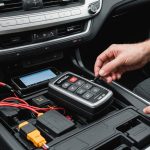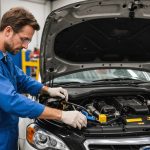Understanding Non-OEM Parts
In the realm of vehicle repairs, understanding the difference between OEM and non-OEM parts can be crucial. Non-OEM parts, also known as aftermarket components, are items not made by the original equipment manufacturer. Usually produced by third-party companies, they are designed to fit a variety of vehicle models. For example, a battery from a non-OEM supplier promises compatibility across multiple brands.
Many consumers opt for non-OEM parts due to their affordability and availability. Since aftermarket components are typically mass-produced, they tend to come at a lower cost than their OEM counterparts. Additionally, they are often more readily available, making them an attractive option for urgent repairs. Drivers might also like the wider choice they offer, from budget-friendly options to high-performance enhancements.
Also read : Top Tips for Sunroof Care: How to Prevent Leaks During Rainy Weather
Understanding the distinction between OEM and aftermarket parts is key. OEM parts are crafted by the original manufacturer, ensuring a direct fit and compatibility, whereas non-OEM parts are produced by external companies that might offer a broader range of features or materials. These differences can lead to variations in quality and fit, requiring consumers to research to ensure they make an informed decision that suits their specific needs and preferences.
Safety Risks of Non-OEM Parts
Exploring the use of non-OEM parts reveals various safety risks and potential impacts on vehicle dependability. While these parts may offer cost savings, understanding their influence on overall vehicle performance, and their reliability concerns is essential.
Also read : Top Tips for Sunroof Care: How to Prevent Leaks During Rainy Weather
Impact on Vehicle Performance
Utilising non-OEM parts can compromise the effectiveness of your vehicle. These components may not be designed with the specific tolerances or materials intended by the vehicle manufacturer, resulting in suboptimal performance and possible safety hazards. A car’s braking system, for example, might not function efficiently with non-OEM brake pads, causing longer stopping distances.
Failure Rates of Non-OEM Parts
Statistics indicate higher failure rates for non-OEM parts when compared to their OEM counterparts. Research shows these parts may fail 20-30% more frequently, prompting both safety and financial concerns for vehicle owners. This increased failure rate can lead to frequent replacements or repairs, ultimately negating the initial cost-saving benefits.
Real-World Consequences
Real-world case studies highlight significant safety incidents linked to non-OEM parts. Instances include brake malfunctions and suspension failures leading to accidents, emphasising the potential hazards these parts pose. Such safety risks underline the importance of understanding the reliability and effectiveness of parts before making replacement decisions.
Legal Implications of Using Non-OEM Parts
Navigating the legal ramifications of using non-OEM parts can be daunting. If you’re considering non-OEM components, understanding the nuances of warranty policies is crucial. Many manufacturers have specific guidelines indicating that warranties may be voided if repairs involve non-OEM parts. It’s vital to check your specific warranty terms to ensure you don’t inadvertently violate any provisions. This helps protect your rights and maintains the manufacturer’s responsibility towards covered repairs.
On a more complex level, there could be potential liability concerns if an accident is linked back to non-OEM parts. Imagine a situation where a substitute part fails unexpectedly. Should this lead to an incident, determining legal responsibility can become complicated. Both users and manufacturers face potential legal entanglements, emphasizing the importance of compliance with safety standards.
Consumer rights are paramount, presenting both a safeguard and an obligation. You, as a consumer, need to feel empowered to make informed choices without fear of unexpected consequences. Manufacturers, likewise, bear a responsibility to communicate the risks and responsibilities associated with non-OEM parts clearly. Understanding these elements helps balance the scales between innovation and safety, creating an informed framework for those considering alternative components.
Expert Opinions on Non-OEM Parts
Gaining insights from automotive professionals provides valuable perspectives when considering non-OEM parts. Mechanics, for instance, often weigh the benefits of non-OEM parts against those of original equipment manufacturer (OEM) components.
Insights from Mechanics
Mechanics are at the forefront of this discussion, as they possess hands-on experience with both OEM and non-OEM components. Many mechanics highlight the cost-effectiveness of non-OEM parts, suggesting that they often present a financially attractive option without compromising functionality. However, they also emphasise the variability in quality, urging consumers to choose reputable aftermarket manufacturers to ensure reliability.
Considerations from Safety Experts
Safety experts play a critical role in evaluating the risks associated with non-OEM components. While some aftermarket parts meet or even exceed safety standards, others may not. Experts warn that critical systems, such as braking and airbags, require components that adhere strictly to safety specifications to avoid increasing accident risks. Therefore, relying on expert analysis is crucial when selecting such parts.
Manufacturers’ Perspectives
Manufacturers of vehicles often have specific recommendations regarding the use of aftermarket parts. Typically, they advocate for OEM parts, arguing they are designed and tested specifically for their vehicles, ensuring optimal performance. However, they also acknowledge that certain non-OEM components can offer suitable alternatives when properly vetted. Understanding these diverse recommendations helps consumers make informed decisions about vehicle repairs and maintenance.
Common Misconceptions about Non-OEM Parts
When it comes to non-OEM parts, several misconceptions cloud public perception. A common belief is that all non-OEM parts are inherently inferior to OEM parts. While it is true some non-OEM parts might not match OEM standards, it is crucial to understand that quality can significantly vary among non-OEM options. Reputable manufacturers often produce high-quality non-OEM parts that can meet or even exceed OEM specifications.
Another prevalent myth is regarding cost savings. Many consumers believe choosing non-OEM parts is always cheaper but at the expense of safety. This is not universally accurate. Although non-OEM parts can offer considerable cost savings, especially for minor repairs, this doesn’t automatically imply compromised safety. It’s essential to weigh the specifics of the part in question and its application.
Moreover, myths about liability persist, suggesting that using non-OEM parts voids warranties. While some manufacturers might discourage non-OEM parts, it’s not always the case that warranties are voided. Consumers should verify warranty stipulations and consult professionals when considering non-OEM options to ensure informed decisions. In summary, understanding these nuances can lead to a more nuanced view of non-OEM parts and their place in the repair and replacement markets.
Recommendations for Informed Repair Choices
Navigating auto repairs can be daunting without proper guidance. Making informed decisions ensures peace of mind and your vehicle’s longevity.
Evaluating Parts Quality
When considering repair choices, one crucial step is evaluating the quality of non-OEM parts. While these parts can be cost-effective, quality can vary significantly. To make informed decisions, scrutinise the part’s warranty, material, and customer reviews. Check if it meets industry standards and has been tested for durability. This careful assessment will aid consumers in making prudent repair choices.
Seeking Certified Repair Shops
Selecting a repair shop is another critical decision. Opt for certified mechanics, as they possess verified skills and knowledge. Certifications such as ASE (Automotive Service Excellence) reassure consumers of a mechanic’s qualifications. Certified shops also likely adhere to ethical business practices, providing an additional layer of security.
Understanding Manufacturer Guidelines
Following manufacturer guidelines is vital for any repair work. These specifications ensure that vehicles remain compliant with factory standards. Often found in the vehicle’s manual, these guidelines offer precise instructions on part specifications and repair processes. Adhering to them prevents potential warranty voids and is part of consumer guidance to protect investments. Always prioritise these guidelines for a seamless repair experience.











